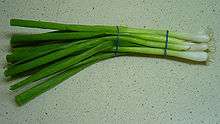蔥
See also: 葱
| ||||||||
Translingual
Han character
蔥 (radical 140, 艸+11, 17 strokes, cangjie input 廿竹田心 (THWP), four-corner 44332, composition ⿱艹悤)

Usage notes
In the mainland China and Hong Kong standards, 蔥 is a variant form of 葱, where the middle component of the character is written as 囱. In the Taiwan stroke order for 蔥, the middle component is written as 囪.
References
- KangXi: page 1055, character 11
- Dai Kanwa Jiten: character 31825
- Dae Jaweon: page 1517, character 24
- Hanyu Da Zidian: volume 5, page 3281, character 2
- Unihan data for U+8525
Chinese
| trad. | 蔥/葱 | |
|---|---|---|
| simp. | 葱 | |
| variant forms | 茐 second round simplified | |
Glyph origin
| Characters in the same phonetic series (囱) (Zhengzhang, 2003) | |
|---|---|
| Old Chinese | |
| 牎 | *sʰroːŋ |
| 窗 | *sʰroːŋ |
| 窓 | *sʰroːŋ |
| 囱 | *sʰroːŋ, *sʰloːŋ |
| 總 | *ʔsloːŋʔ |
| 熜 | *ʔsloːŋʔ |
| 傯 | *ʔsloːŋʔ |
| 緫 | *ʔsloːŋʔ |
| 揔 | *ʔsloːŋʔ |
| 偬 | *ʔsloːŋʔ, *ʔsloːŋs |
| 囪 | *sʰloːŋ |
| 璁 | *sʰloːŋ |
| 驄 | *sʰloːŋ |
| 蔥 | *sʰloːŋ |
| 匆 | *sʰloːŋ |
| 怱 | *sʰloːŋ |
| 葱 | *sʰloːŋ |
| 楤 | *sʰloːŋ |
| 聦 | *sʰloːŋ |
| 繱 | *sʰloːŋ |
| 騘 | *sʰloːŋ |
| 鍯 | *sʰloːŋ |
| 聰 | *sʰloːŋ |
| 愡 | *sʰloːŋs |
| 檧 | *sloːŋ, *sloːŋʔ |
| 憽 | *sloːŋ |
| 幒 | *sʰloŋʔ, *kjoŋ |
Phono-semantic compound (形聲, OC *sʰloːŋ) : semantic 艸 (“grass; plant”) + phonetic 悤.
Etymology 1
From Proto-Sino-Tibetan *b-tsuŋ (“onion”). Cognate with Tibetan བཙོང (btsong), ཙོང (tsong, “onion, scallion”).
Pronunciation
Definitions
蔥
Compounds
Etymology 2
Pronunciation
Japanese
Korean
Hanja
蔥 • (chong) (hangeul 총, revised chong, McCune–Reischauer ch'ong, Yale chong)
- This term needs a translation to English. Please help out and add a translation, then remove the text
{{rfdef}}.
Vietnamese
This article is issued from
Wiktionary.
The text is licensed under Creative
Commons - Attribution - Sharealike.
Additional terms may apply for the media files.